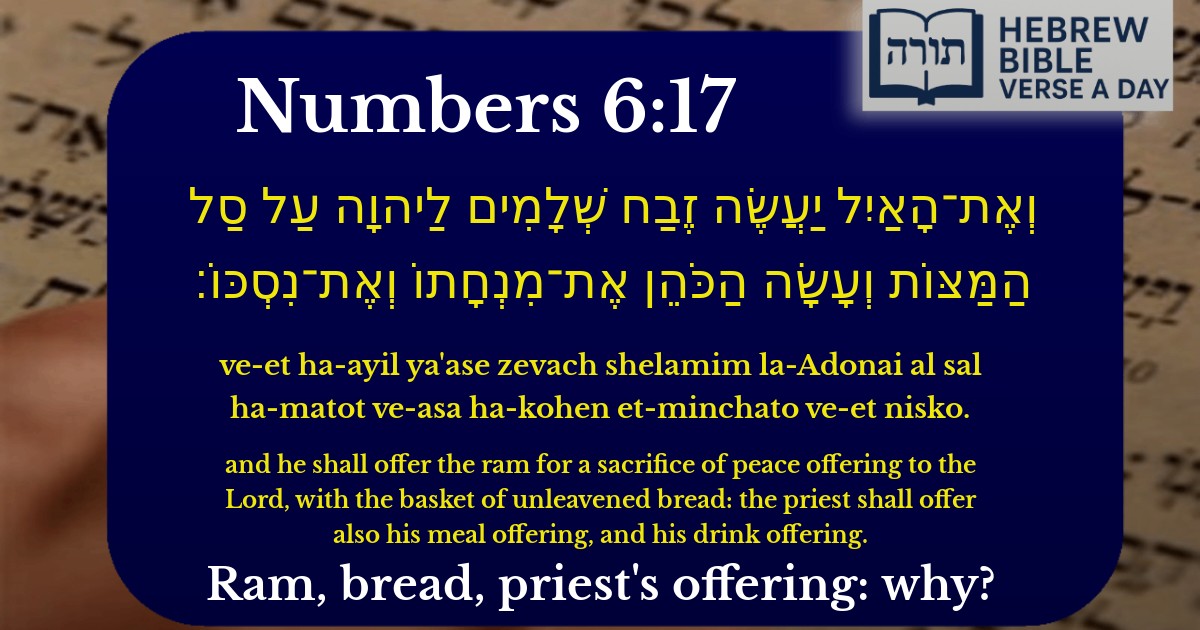Frequently Asked Questions
Q: What does Numbers 6:17 mean in the context of the Nazirite vow?
A: Numbers 6:17 describes part of the process when a Nazirite completes their vow. The ram is offered as a 'peace offering' (zevach shelamim) to Hashem, along with unleavened bread (matzot), a meal offering (mincha), and a drink offering (nesech). According to Rashi, this demonstrates gratitude to Hashem for successfully completing the Nazirite period, which involved abstaining from wine, avoiding haircuts, and maintaining ritual purity.
Q: Why is unleavened bread (matzot) mentioned in Numbers 6:17?
A: The basket of unleavened bread (shel matzot) accompanies the peace offering as part of the Nazirite's final sacrifices. The Talmud (Menachot 78a) explains that matzah, which lacks leaven (chametz), symbolizes humility and purity—qualities fitting for someone who has taken on extra spiritual discipline through the Nazirite vow.
Q: What is the significance of the peace offering (zevach shelamim) in this verse?
A: The peace offering (zevach shelamim) in Numbers 6:17 represents harmony between the individual, Hashem, and the community. Rambam (Hilchot Ma'aseh HaKorbanot 9:1) teaches that this offering expresses gratitude and joy, as the Nazirite celebrates the completion of their vow in a way that also allows others (like the Kohanim and donors) to partake in the meal.
Q: Who performs the offerings in Numbers 6:17, and why?
A: The verse states that 'the priest (Kohen) shall offer' the meal and drink offerings. This highlights the role of the Kohanim in facilitating divine service, as explained in the Midrash (Sifrei Bamidbar). Only Kohanim, who are sanctified for Temple service, may perform these rituals, ensuring they are done according to halacha (Jewish law).
Q: How does Numbers 6:17 apply to us today without the Temple?
A: While we cannot bring sacrifices today, the principles behind Numbers 6:17 remain relevant. The Sefer HaChinuch (Mitzvah 377) teaches that offerings like the peace offering remind us to express gratitude to Hashem. Today, we can fulfill this through prayer (tefillah), charity (tzedakah), and dedicating time to spiritual growth, just as the Nazirite did.


Context in Vayikra (Leviticus)
The verse (Vayikra 7:37) appears in the context of the laws of sacrifices, specifically detailing the zevach shelamim (peace offering) and its accompanying meal and drink offerings. The shelamim is unique among sacrifices, as it is shared between the altar, the kohanim, and the one bringing the offering, symbolizing peace and harmony between Hashem, the priests, and the Jewish people.
Rashi's Explanation
Rashi (Vayikra 7:37) notes that the phrase "עַל סַל הַמַּצּוֹת" ("with the basket of unleavened bread") refers to the mincha (meal offering) that accompanies the ram. He explains that this is part of the korban todah (thanksgiving offering), a subset of the shelamim, which requires both matzos and chametz (leavened bread) to be brought alongside it (as detailed in Vayikra 7:12-13).
Rambam on the Shelamin
In Hilchos Maaseh HaKorbanos (9:1-3), the Rambam elaborates on the laws of the shelamim, emphasizing that the meal and drink offerings (mincha and nesech) are integral to the sacrifice. The mincha consists of fine flour mixed with oil, while the nesech is wine, both symbolizing gratitude and sustenance from Hashem.
Symbolism of the Offerings
Midrashic Insight
The Midrash (Vayikra Rabbah 9:7) connects the shelamim to the concept of shalom (peace), teaching that one who brings this offering fosters peace between themselves, Hashem, and the community. The inclusion of both matzos and chametz in the korban todah underscores the balance between spiritual humility (matzos) and material gratitude (chametz).